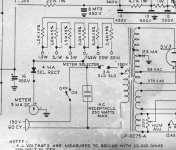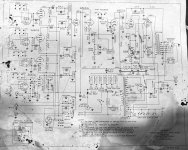I have a Knight KN 3050 amplifier that I am currently working on.
It has a nifty output level meter that seems to need a new rectifier.
It currently has one of the miniature two lead selenium rectifier diodes with a red dot by one lead ( never saw one like this before). Schematic says 4ma. What silicon would be appropriate for this replacement?
And would a dropping resistor be appropriate for the different voltage drop?
It has a nifty output level meter that seems to need a new rectifier.
It currently has one of the miniature two lead selenium rectifier diodes with a red dot by one lead ( never saw one like this before). Schematic says 4ma. What silicon would be appropriate for this replacement?
And would a dropping resistor be appropriate for the different voltage drop?
Attachments
Any small diode such as 1N4005 or similar. Even 1N4148 is ok.
But add a series resistor to the diode to keep the calibration of the meter.
Find the proper resistance by a low power test on the lowest meter setting.
But add a series resistor to the diode to keep the calibration of the meter.
Find the proper resistance by a low power test on the lowest meter setting.
Thanks! I have both in the pirate stash. The rest of the restoration is already complete. When I got it, it had a pair of Mullard 6CA7, all the rest were RCA. Those Mullard tubes sound great, but would be a poor choice for guitar use, as they are nice candidates for st-70 use. I installed a set of JJ and they work like a charm. Without any modifications and just restoration, it doesn’t sound like a Marshall, more like a Hiwatt or a Laney. With the four independent microphone inputs, I could do lots of fun things with it like cascading two for an insane gain channel. The tone stack is not ideal for guitar, so that will get a bit of modification. Point to point wiring is so easy to mod and easy to mod again.
Lou
Lou
One trick to match a selenium rectifier is to recognize that it drops about 1 volt per plate. So for a single plate replacement a silicon diode such as a 1N4148 in series with a real 1N34 would do. The problem is many diodes sold today for a 1N34 are actually Schottky diodes and have a different voltage drop. But aim for a 1 volt drop in use.

